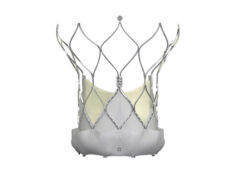
In a research letter published in the Journal of the American College of Cardiology, Gennaro Giustino (The Icahn School of Medicine, Mount Sinai Hospital, New York, USA) and others report that the use of an embolic protection device during transcatheter aortic valve implantation (TAVI) is associated with a significant reduction in the risk of stroke or death. However, they add that further data—particularly for the individual embolic protection devices available—are warranted.
The authors note that preliminary data “suggest that embolic protection may reduce cerebral infarction markers or improve early cognition” but add the effect of devices, when deployed during TAVI, on hard clinical endpoints “remain unclear”. Therefore, they performed a systematic review and aggregate data meta-analysis of randomised controlled trials—including the recently published SENTINEL trial (which evaluated Claret Medical’s Sentinel cerebral protection system)—that have evaluated the use of embolic protection devices.
Five studies that, overall, enrolled 625 patients were included in the meta-analysis. Of these 625 patients, 376 had been randomised to undergo TAVI with embolic protection and 249 had randomised to undergo TAVI without embolic protection. Giustino et al note that while their meta-analysis reviewed different devices, the same device was used within each trial. They add that the primary clinical endpoint was the risk of stroke or death at the longest follow-up point available according to the intention-to-treat principle.
“Embolic protection had a lower risk of death or stroke on relative and absolute terms (6.4% vs. 10.8% for without embolic protection; p=0.04). Results were consistent following stratification by type of embolic protection device used,” the authors report. They comment that embolic protection, according to the results of the meta-analysis, was associated a 4% absolute reduction in the risk of stroke or death with a numbers needed to treat of 22.
Giustino et al observe that their findings “suggest that embolic protection may be a clinically relevant adjunctive strategy in patients undergoing TAVI”, noting it is plausible that “the magnitude of the benefit may be accentuated in patients at high risk for cerebrovascular complications”. Furthermore, given that subclinical ischaemic brain injury is “associated with both cognitive and functional neurological impairment over time”, they state: “Prevention of subclinical embolisation may be particularly important when treating younger and lower risk patients with severe aortic stenosis.”
Concluding the research letter, the authors write that “additional evidence of embolic protection effectiveness is warranted, particularly on individual embolic protection device performance and safety”.
Study author George Dangas (The Zena and Michael A Wiener Cardiovascular Institute, Icahn School of Medicine at Mount Sinai, New York, USA) told Cardiovascular News that their study provides “an “aerial view of the entire and quite interesting field” of cerebral protection and, therefore, was not able to provide further insight into the findings of the SENTINEL trial, which indicated that there was little benefit with using cerebral protection with the next-generation TAVI device Sapien 3 (Edwards Lifesciences). He notes: “If specific questions on specific embolic protection devices and specific valves are to be asked, then specifically designed trials would need to be conducted before any secure statement can be offered.”










